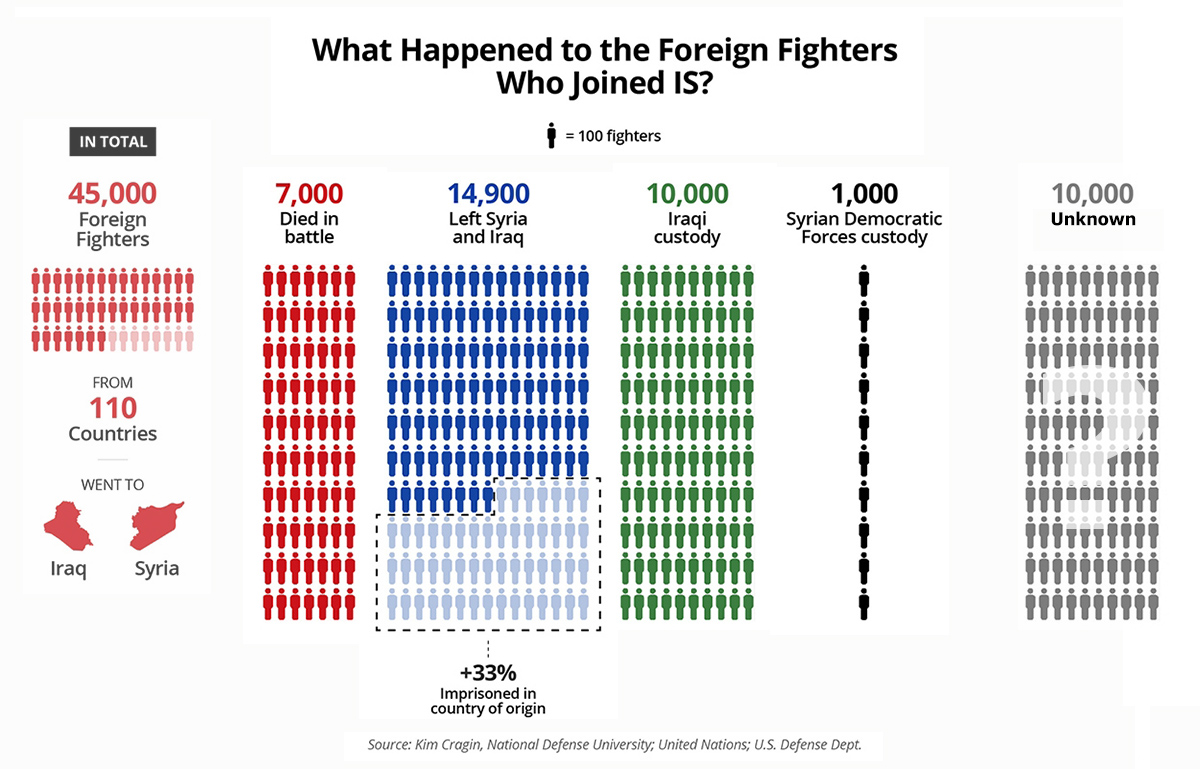“Always after a defeat and a respite, the Shadow takes another shape and grows again” – J. R. R. Tolkien.
The world (or most of it) breathed a sigh of relief earlier this year when the Islamic State’s Caliphate in the Middle-East was finally crushed. As the last, black-clad rats bolted from their holes, in grinding house-to-house urban warfare, it seemed as if one of the great evils of modern times had finally been defeated.
But has it?
The Islamic State terror group has set conditions for a comeback that “could be faster and even more devastating” than when it first burst onto the world stage, according to a new report out Wednesday.
voanews
The Islamic State group has lost its caliphate in Syria and Iraq, but in the forbidding mountains of northeastern Afghanistan the group is expanding its footprint, recruiting new fighters and plotting attacks on the United States and other Western countries, according to U.S. and Afghan security officials.
IS established a presence in Afghanistan soon after its initial emergence in Iraq and Syria, just as it established outposts in Yemen, Libya, Algeria and South-East Asia. There are now claims that its apparent defeat in its homeland caliphate is more a strategic retreat. It’s unknown just how many foreign fighters flocked to the caliphate, but numbers are estimated at around 45 000. Of the 15 000 known to have fled Syria and Iraq, two-thirds are at large in their countries of origin. More than ten thousand foreign fighters are simply unaccounted for.

In the wake of the caliphate’s collapse, an immediate concern was that IS foreign fighters would become local recruiters and plotters for home-grown terrorists.
Authorities have also already made at least eight arrests in the United States linked to the IS affiliate in Afghanistan.
Martin Azizi-Yarand, the 18-year-old Texan who plotted a 2018 attack on a suburban mall, said he was inspired by IS and was preparing to join the affiliate in Afghanistan…Rakhmat Akilov, the 39-year-old Uzbek who plowed his truck into pedestrians in Stockholm in 2017, also had links with the Afghanistan affiliate…
But it’s also claimed that IS fighters have fled to Afghanistan as a base to relaunch its caliphate.
The Islamic State group has lost its caliphate in Syria and Iraq, but in the forbidding mountains of northeastern Afghanistan the group is expanding its footprint, recruiting new fighters and plotting attacks on the United States and other Western countries, according to U.S. and Afghan security officials…Concerns run so deep that many have come to see the Taliban, which have also clashed with IS, as a potential partner in containing it…
A U.S. intelligence official based in Afghanistan told The Associated Press that a recent wave of attacks in the capital, Kabul, is “practice runs” for even bigger attacks in Europe and the United States.
apnews
IS are believed to have fled to the mountains which once provided shelter for Osama bin Laden and were one of the deadliest regions for coalition forces in the Afghanistan war. But there are also claims that IS is ready not only to launch a wave of foreign attacks and plant its black flag in Afghanistan but is also poised to sweep back to power in its former caliphate.
ISIS’s Second Comeback: Assessing the Next ISIS Insurgency, by the Washington-based Institute for the Study of War (ISW), also warns the terror group, often referred to as IS or ISIS, is likely to reclaim territory both in Syria and in Iraq, where it is already seizing control.
“ISIS has systematically eliminated village leaders and civilians who cooperated with anti-ISIS forces,” the report says. “It has re-imposed taxes on local populations in its historical support zones, displacing civilians and de facto controlling small pockets of terrain in Iraq…ISIS deliberately withdrew and relocated many of its fighters and their families,” the reports states.
…As far back as August 2018, U.S. defense officials were warning IS was “well-positioned to rebuild and work on enabling its physical caliphate to re-emerge.”
voanews
IS sleeper cells in Syria have allegedly been waging an insurgency campaign of increasing terror attacks, as well as burning farmland, to remind “liberated” communities that they are still under threat. By perpetuating fear and distrust, IS is hoping to weaken attempts to re-establish legitimate political and security structures, leaving the way open for an easy reconquest.
What to make of all this? It’s possible that these warnings are part of a deep-state led effort to undermine the Trump administration’s efforts to pull America out of its endless wars. As Tim Poole also warns, not only are some anti-Trump forces reflexively opposed to anything Trump does, others simply seem to be addicted to war.
On the other hand, it would be foolish to wave IS away as a defeated force. As the counter-terror raids in Australia, and attacks overseas, show, IS is far from dead as an ideological force. In fact, defeating the caliphate may have simply driven it from plain sight.








